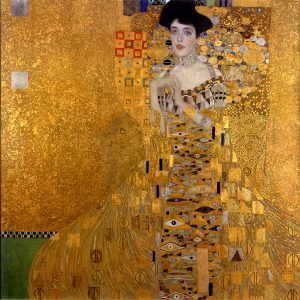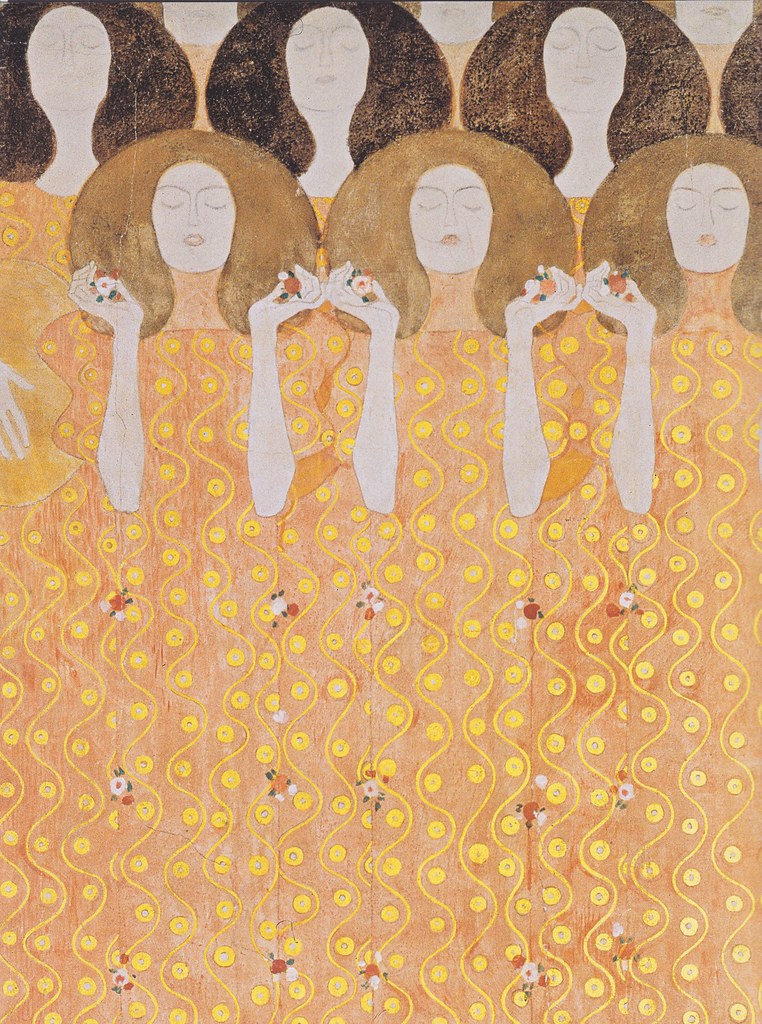Gustav Klimt was a successful Austrian symbolist painter of unconventional architectural decoration and was also one of the most prominent members of the Vienna Secession movement.

Image source: https://search.creativecommons.org/photos/12c3f7c3-e0b3-4094-95ac-108e51c888a5 by Peter K. Levy
Gustav Klimt, born in 1862, was an Austrian painter known for the highly decorative style and erotic nature of his works, seen as an act of rebellion against the traditional academic art of his time. The Kiss and Portrait of Adele Bloch-Bauer are his most famous paintings.
Poverty
![[ N ] Moriz Nähr - Gustav Klimt (1912)](https://live.staticflickr.com/5014/5504324780_e971fbe513_b.jpg)
Gustav Klimt was born on July 14, 1862, on the outskirts of Vienna, Austria. His father, Ernst, was a gold engraver who emigrated to Vienna from Bohemia, and his mother, Anna, was musically talented but never managed to become a professional musician. Klimt showed considerable talent from an early age, and at 14 he left his regular school to attend the Vienna School of Arts and Crafts on a scholarship, which is no small feat given his young age and the relative poverty in which he was grown up. While at the institute, Klimt received classical and conservative training which he readily accepted and concentrated his studies on architectural painting.

Image source: https://search.creativecommons.org/photos/ecea4eda-d915-41b4-8886-486dba4db7e3 by Chicago Art Department
The company of artists

Image source: https://search.creativecommons.org/photos/c882d357-18d9-48f6-9175-5e1dd8ced60c by Boris from Vienna
Klimt’s horizons began to broaden as his talent earned him various small commissions while still in school, and after his graduation in 1883, he opened a studio with his younger brother Ernst and their mutual friend Franz Masch. Calling themselves the Company of Artists, the trio focused their work on murals putting aside any personal artistic inclinations in favor of the historical style popular among upper-middle-class and the Viennese aristocracy at the time. That decision turned out to be a good one, as it allowed them numerous commissions to paint churches, theaters, and other public spaces, but most importantly to work interchangeably on their projects. Their most notable works during this time were the mural at the Burgtheater in Vienna and the ceiling above the staircase at the Kunsthistorisches Museum.
Secession

Image source: https://search.creativecommons.org/photos/ace2571a-a416-4587-89e2-cbe8b0cae0ad by yellow book
Klimt became a founding member and president of the Wiener Sezession (Vienna Secession) in 1897 and of the group’s periodical, Ver Sacrum (“Sacred Spring”). He remained with the Secession until 1908. The group’s goals were to provide exhibitions for unconventional young artists, bring the works of the best foreign artists to Vienna, and publish its magazine to show the work of the members. The group did not declare any manifestoes and did not set out to encourage any particular style—Naturalists, Realists, and Symbolists all coexisted. The government supported their efforts and leased their public land to erect an exhibition hall. The symbol of the group was Pallas Athena, the Greek goddess of just causes, wisdom, and the arts—of which Klimt painted his radical version in 1898.

Image source: https://search.creativecommons.org/photos/9b66b690-1ce0-410c-9615-2a6745042f47 by Image Catalog
Klimt’s Golden phase
Klimt’s ‘Golden Phase’ was characterized by positive criticism and financial success. Many of his paintings from this period included gold leaf. Klimt had previously used gold in his Pallas Athene (1898) and Judith I (1901), although the works most commonly associated with this period are the Portrait of Adele Bloch-Bauer I (1907) and The Kiss (1907–08).

Images source: https://search.creativecommons.org/photos/d042af76-a7cd-4489-a251-10551c9890e2 by Tulip Hysteria / Go to albums
Klimt used to wear sandals and a long robe with no undergarments while working and relaxing in his home. His life was mainly devoted to art, family, and little else except the Secessionist Movement. He avoided the café company and rarely socialized with other artists. Klimt’s fame brought customers to his door while also allowing himself to be highly selective. His pictorial method was at times very thoughtful and scrupulous and required long sessions on the part of his subjects. Although very sexually active, he kept his business discreet while avoiding personal scandal. Klimt wrote little about his vision or methods.

Images source: https://search.creativecommons.org/photos/853af66e-2b95-42ff-ae11-807f3946d9c6 by Tulip Hysteria / Go to albums
Info sources:
https://www.biography.com/artist/gustav-klimt https://en.wikipedia.org/wiki/Gustav_Klimt https://www.britannica.com/biography/Gustav-Klimt http://expo-klimt.com/
